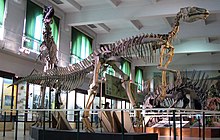| Austrokritosaurs Temporal range:
Late Cretaceous,
~ | |
|---|---|

| |
| Skeletal mount of Huallasaurus, an austrokritosaur, at the Natural Sciences Museum | |
|
Scientific classification
| |
| Domain: | Eukaryota |
| Kingdom: | Animalia |
| Phylum: | Chordata |
| Clade: | Dinosauria |
| Clade: | † Ornithischia |
| Clade: | † Ornithopoda |
| Family: | † Hadrosauridae |
| Subfamily: | † Saurolophinae |
| Clade: | †
Austrokritosauria Alarcón-Muñoz et al., 2023 |
| Genera | |
Austrokritosauria is an extinct clade of saurolophine dinosaurs known from the Late Cretaceous of South America. The clade provides evidence of a faunal exchange from North America during the Cretaceous. [1]
Description
Austrokritosaurs were medium to large herbivorous "duck-billed" ( hadrosaur) ornithopod dinosaurs. They ranged in size from the smaller (possibly immature) Secernosaurus, at 4–5 metres (13–16 ft), to the larger Kelumapusaura, at around 8–9 metres (26–30 ft). [2] [3]
Biogeography

Alarcón-Muñoz et al. (2023) suggested that austrokritosaurs shared an ancestor with the North American kritosaurins in the Santonian, about 85 million years ago, before dispersing into South America. This likely occurred via island chains and rafting. The South American hadrosauroid Gonkoken appears to have diverged from North American hadrosauroids at an even earlier time, about 91 million years ago in the Turonian. [1] The Argentinian nodosaurid Patagopelta and North American titanosaur Alamosaurus likely experienced similar dispersal events from relatives in North and South America in the late Campanian–early Maastrichtian. [4] [5]
Classification
In the 2023 description of Gonkoken, Alarcón-Muñoz et al. erected Austrokritosauria as a new clade within the Saurolophinae, as a sister taxon to the Kritosaurini. Their phylogenetic matrix was modified from a 2022 study by Rozadilla et al. naming the hadrosaurs Huallasaurus and Kelumapusaura, which Alarcón-Muñoz et al. (2023) identified as austrokritosaurs. [3] Austrokritosauria is defined as "the most inclusive clade containing Huallasaurus but not Gryposaurus". The results of their phylogenetic analyses of Saurolophinae are displayed in the cladogram below: [1]
| Saurolophinae |
| ||||||||||||||||||||||||||||||||||||||||||||||||||||||
See also
References
- ^ a b c Alarcón-Muñoz, Jhonatan; Vargas, Alexander O.; Püschel, Hans P.; Soto-Acuña, Sergio; Manríquez, Leslie; Leppe, Marcelo; Kaluza, Jonatan; Milla, Verónica; Gutstein, Carolina S.; Palma-Liberona, José; Stinnesbeck, Wolfgang; Frey, Eberhard; Pino, Juan Pablo; Bajor, Dániel; Núñez, Elaine; Ortiz, Héctor; Rubilar-Rogers, David; Cruzado-Caballero, Penélope (2023-06-16). "Relict duck-billed dinosaurs survived into the last age of the dinosaurs in subantarctic Chile". Science Advances. 9 (24). doi: 10.1126/sciadv.adg2456. ISSN 2375-2548. PMC 10275600.
- ^ Coria, Rodolfo A (2015). "South American hadrosaurs: considerations on their diversity". In Eberth, David A.; Evans, David C. (eds.). Hadrosaurs. Life of the past. Bloomington and Indianapolis: Indiana University Press. pp. 332–339. ISBN 978-0-253-01390-3.
- ^ a b Rozadilla, Sebastián; Brissón-Egli, Federico; Agnolín, Federico Lisandro; Aranciaga-Rolando, Alexis Mauro; Novas, Fernando Emilio (2022-02-24). "A new hadrosaurid (Dinosauria: Ornithischia) from the Late Cretaceous of northern Patagonia and the radiation of South American hadrosaurids". Journal of Systematic Palaeontology. 19 (17): 1207–1235. doi: 10.1080/14772019.2021.2020917. ISSN 1477-2019. S2CID 247122005.
- ^ Riguetti, Facundo; Pereda-Suberbiola, Xabier; Ponce, Denis; Salgado, Leonardo; Apesteguía, Sebastián; Rozadilla, Sebastián; Arbour, Victoria (2022-12-31). "A new small-bodied ankylosaurian dinosaur from the Upper Cretaceous of North Patagonia (Río Negro Province, Argentina)". Journal of Systematic Palaeontology. 20 (1): 2137441. doi: 10.1080/14772019.2022.2137441. ISSN 1477-2019. S2CID 254212751.
- ^ Chiarenza, Alfio Alessandro; Mannion, Philip D.; Farnsworth, Alex; Carrano, Matthew T.; Varela, Sara (2021-12-17). "Climatic constraints on the biogeographic history of Mesozoic dinosaurs". Current Biology. 32 (3): 570–585.e3. doi: 10.1016/j.cub.2021.11.061. hdl: 11093/5013. ISSN 0960-9822. PMID 34921764. S2CID 245273901.







